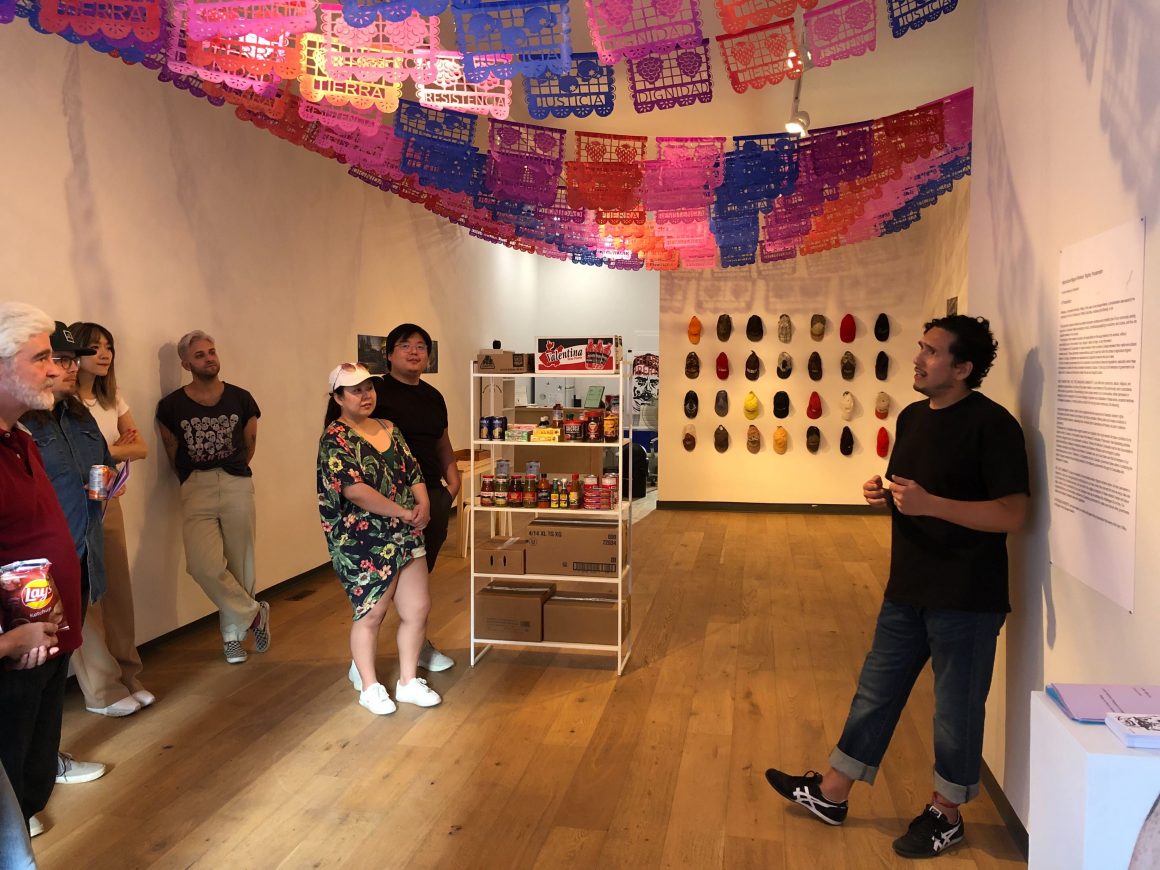
Little Mexico: a migrant worker’s journey from home to home
By Riley Stovka, May 29 2023
The New Gallery is in a storefront along Calgary’s Centre Street in Chinatown, sandwiched between a massage parlour and a hair salon. It’s fairly nondescript: the angle of the building makes it hard to tell what it is from the sidewalk and when speeding down the Centre Street bridge the signage is almost impossible to read.
I stood on the sidewalk and knocked on the big steel door and within a couple of seconds Chrisitna, the gallery’s only employee that day, unlocked the door and ushered me inside. The gallery space itself is quite small — it occupies only a single floor of the storefront. On a table by the door is a stack of blue booklets that share details of the new exhibition Little Mexico by Carlos Colin, a Vancouver-based visual artist who has had exhibitions in the Latin American BIENALSUR, AWA Cultura in Caracas, Venezuela and the Art Gallery of Greater Victoria.
Along the windows in the front of the gallery are small wooden stools arranged in a row and Festividad en Dias Soleados flags hanging from the roof. On one wall is a pair of identical white posters tacked side by side. Painted in black on the posters is the face of legendary Mexican revolutionary Emiliano Zapata, and above Zapata, painted in red on his forehead is “Tierra y Libertad”, meaning land and freedom.
Across from Zapata on the other wall is a projector screening pictures of Mexican migrant workers doing an assortment of things, like spending time with family, resting on a couch in their homes or enjoying a sunny day on their porch with friends, drinking cervezas. On the back wall are sweaty, weather-beaten hats, arranged in rows. They hang from plastic clips and many can be seen in the photographs that flick past on the projector. In the middle of the room is a metal storage unit standing about six feet high. On the shelves of the unit are boxes of Valentina hot sauce, cans of Guava and Mango nectar, Mexican brand instant coffee, canned sardines by the brand La Reina, La Costena Ranchera sauce, and Herdez brand salsa.
Walking around the gallery, it’s not hard to understand the purpose of Carlos Colin’s visual art. Colin is attempting to showcase the relationship between the lives of Mexican migrant workers and the land where they do their work. As Colin himself states in flyers found around the gallery, he hopes the project will “critically engage with the community of Mexican labourers, their socio-political-cultural diasporic contribution to British Columbia, where the project was created, and Canada.”
At the heart of Little Mexico is Colin’s desire to highlight what he calls “sporadic diaspora”, the “…constant human dislocation where […] Mexican worker family members have the need to leave their place of origin, families and communities.” He does this through visual aids like the pictures on the projector, or through the collection of groceries at the centre of the room.
In Land without Freedom is Dust, an essay by Mexican-born and British Columbia-based photographer Rocio Graham which was printed and tucked inside the gallery’s guidebook, Graham connects the land-centred freedom movement of the Mexican Revolution with Canada’s own checkered history with such movements.
Mexico’s nearly decade-long revolution has its roots in land reform desires among working-class labourers and other agricultural workers. Leaders like Emiliana Zapata fought and died for land and freedom for all Mexicans, but when the revolution came to an end, the land reform that was fought for was never truly implemented, leading to decades of political and socio-economic frustration that still plague the country today. The connection to Canada is in this regard—land claims among Indigenous people in Canada have been largely ignored or outright refused. The consequences of the injustices of colonialism in both Mexico and Canada are complex in a historical context but the solution has always been clear in practical terms.
People are irrevocably tied to the land they live and work on. It shapes identities, becoming a connection to the past and the future. Colin uses visual portraits to demonstrate how meaningful the relationship between a person and land can be. Through a connection to home and family, migrant workers “represent a humanity and relatability”.
On a table at the back of the gallery are a collection of postcards. On the cards are photographs taken in a Filipino grocery store where Mexican migrant workers buy their groceries and send money back to their families. Gallery visitors are invited to take any postcard they like and use it to send to loved ones away from home. In my pocket, as I left the gallery, was a sharp-edged postcard with a close-up of Chile Habanero hot sauce on one side, the categories of which are red, green, black, and xxxtra hot.
Aside from a nifty souvenir, Colin hopes the postcards—and by extension the rest of the gallery— “demonstrates the power of the individual to help advance social justice…[and to] energize the conversation about equitable treatment of migrant workers…and their inclusion in the Canadian social tapestry.”
More information about Little Mexico by Carlos Colin can be found here. The New Gallery is currently running the Little Mexico exhibit from May 5 to June 17.
